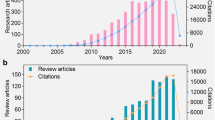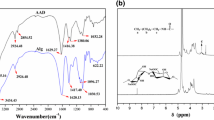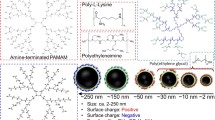Abstract
Nanoporous silica materials have become a prominent novel class of biomaterials which are typically applied as nanoparticles or thin films. Their large surface area combined with the rich surface chemistry of amorphous silica affords the possibility to equip this material with variable functionalities, also with several different ones on the same particle or coating. Although many studies have shown that nanoporous silica is apparently non-toxic and basically biocompatible, any surface modification may change the surface properties considerably and, therefore, the modified materials should be checked for their biocompatibility at every step. Here we report on different silane-based functionalization strategies, firstly a conventional succinic anhydride-based linker system and, secondly, copper-catalyzed click chemistry, to bind polysialic acid, a polysaccharide important in neurogenesis, onto nanoporous silica nanoparticles (NPSNPs) of MCM-41 type. At each of the different modification steps, the materials are characterized by cell culture experiments. The results show that polysialic acid can be immobilized on the surface of NPSNPs by using different strategies. The cell culture experiments show that the kind of surface immobilization has a strong influence on the toxicity of the material versus the cells. Whereas most modifications appear inoffensive, NPSNPs modified by click reactions are toxic, probably due to residues of the Cu catalyst used in these reactions.
















Similar content being viewed by others
References
Barbé C, Bartlett J, Kong L, Finnie K, Lin HQ, Larkin M, Calleja S, Bush A, Calleja G. Silica particles: novel drug delivery system. Adv. Mater. 2004;16:1959–66.
Liu HM, Wu SH, Lu CW, Yao M, Hsiao JK, Hung Y, Lin YS, Mou CY, Yang CS, Huang DM. Mesoporous silica nanoparticles improve magnetic labeling efficiency in human stem cells. Small. 2008;4:619–26.
Trewyn BG, Giri S, Slowing II, Lin VSY. Mesoporous silica nanoparticles based controlled released, drug delivery and biosensor systems. Chem. Commun. 2007;31:3236–45.
Baeza A, Guisasola E, Ruiz-Hernández E, Vallet-Regí M. Magnetically triggered multidrug release by hybrid mesoporous silica nanoparticles. Chem. Mater. 2012;24:517–24.
Fried DI, Schlossbauer A, Bein T. Immobilizing glycopyranose on mesoporous silica via “click chemistry” for borate adsorption. Microporous Mesoporous Mater. 2012;147:5–9.
Lim JS, Lee K, Choi JN, Hwang YK, Yun MY, Kim HJ, Won YS, Kim SJ, Kwon H, Huh S. Intracellular protein delivery by hollow mesoporous silica capsules with a large surface hole. Nanotechnology. 2012;23:1–11.
Tagaya M, Ikoma T, Yoshioka T, Motozuka S, Xu Z, Minami F, Tanaka J. Synthesis and luminescence properties of Eu(III)-doped nanoporous silica spheres. J. Colloid Interface Sci. 2011;363:456–64.
Argyo C, Cauda V, Engelke H, Rädler J, Bein G, Bein T. Heparin-coated colloidal mesoporous silica nanoparticles efficiently bind to antithrombin as an anticoagulant drug-delivery system. Chem. Eur. J. 2012;18:428–32.
Ehlert N, Mueller PP, Stieve M, Lenarz T, Behrens P. Mesoporous silica films as a novel biomaterial: applications in the middle ear. Chem. Soc. Rev. 2013;42:3847–61.
Asefa T, Tao Z. Biocompatibility of mesoporous silica nanoparticles. Chem. Res. Toxicol. 2012;25:2265–84.
Phillips E, Penate-Medina O, Zanzonico PB, Carvajal RD, Mohan P, Ye Y, Humm J, Gönen M, Kalaigian H, Schöder H, Strauss HW, Larson SM, Wiesner U, Bradbury MS. Clinical translation of an ultrasmall inorganic optical-PET imaging nanoparticle probe. Sci. Transl. Med. 2014;6:260ra149.
Turck C, Brandes G, Krueger I, Behrens P, Mojallal H, Lenarz T, Stieve M. Histological evaluation of novel ossicular chain replacement prostheses: an animal study in rabbits. Acta Oto-Laryngol. 2007;127:801–8.
Vogt JC, Brandes G, Krueger I, Behrens P, Nolte I, Lenarz T, Stieve M. A comparison of different nanostructured biomaterials in subcutaneous tissue. J. Mater. Sci. 2008;19:2629–36.
Vogt JC, Brandes G, Ehlert N, Behrens P, Nolte I, Mueller PP, Lenarz T, Stieve M. Free Bioverit®II implants coated with a nanoporous silica layer in a mouse ear model—a histological study. J. Biomater. Appl. 2009;24:175–91.
Ehlert N, Badar M, Christel A, Lohmeier SJ, Luessenhop T, Stieve M, Lenarz T, Mueller PP, Behrens P. Mesoporous silica coatings for controlled release of the antibiotic ciprofloxacin from implants. J. Mater. Chem. 2011;21:752–60.
Lensing R, Bleich A, Smoczek A, Glage S, Ehlert N, Luessenhop T, Behrens P, Mueller PP, Kietzmann M, Stieve M. Efficacy of nanoporous silica coatings on middle ear protheses as a delivery system for antibiotics: an animal study in rabbits. Acta Biomater. 2013;9:4815–25.
Ehlert N, Hoffmann A, Luessenhop T, Gros G, Mueller PP, Stieve M, Lenarz T, Behrens P. Amino-modified silica surfaces efficiently immobilize bone morphogenetic protein 2 (BMP2) for medical purposes. Acta Biomater. 2011;7:1772–9.
Chen L, Wen Y, Su B, Di J, Song Y, Jianga L. Programmable DNA switch for bioresponsive controlled release. J. Mater. Chem. 2011;21:13811.
Tan W, Wang K, He X, Zhao XJ, Drake T, Wang L, Bagwe RP. Bionanotechnology based on silica nanoparticles. Med. Res. Rev. 2004;24:621–38.
Asefa T, Otuonye AN, Wang G, Blair EA, Vathyam R, Denton K. Controlling adsorption and release of drug and small molecules by organic functionalization of mesoporous materials. Adsorption. 2009;15:287–99.
Huh S, Wiench JW, Trewyn BG, Song S, Pruski M, Lin VSY. Tuning of particle morphology and pore properties in mesoporous silicas with multiple organic functional groups. Chem. Commun. 2003;18:2364–5.
Qian HS, Guo HC, Ho PCL, Mahendran R, Zhang Y. Mesoporous-silica-coated up-conversion fluorescent nanoparticles for photodynamic therapy. Small. 2009;5:2285–90.
Estèvez MC, O’Donoghue MB, Chen X, Tan W. Highly fluorescent dye-doped silica nanoparticles increase flow cytometry sensitivity for cancer cell monitoring. Nano Res. 2009;2:448–61.
Tsai CP, Chen CY, Hung Y, Chang FH, Mou CY. Monoclonal antibody-functionalized mesoporous silica nanoparticles (MSN) for selective targeting breast cancer cells. J. Mater. Chem. 2009;19:5737–43.
Kim MH, Na HK, Kim YK, Ryoo SR, Cho HS, Lee KE, Jeon H, Ryoo R, Min DH. Facile synthesis of monodispersed mesoporous silica nanoparticles with ultralarge poresand their application in gene delivery. ACS Nano. 2011;5:3568–76.
Torney F, Trewyn BG, Lin VSY, Wang K. Mesoporous silica nanoparticles deliver DNA and chemicals into plants. Nat. Nanotechnol. 2007;2:295–300.
Mühlenhoff M, Echhardt M, Gerardy-Schahn R. Polysialic acid: three-dimensional structure, biosynthesis and function. Curr. Opin. Struct. Biol. 1998;8:558–64.
Angata K, Fukuda M. Polysialyltransferases: major players in polysialic acid synthesis on the neural cell adhesion molecule. Biochimie. 2003;85:195–206.
Rutishauser U. Polysialic acid at the cell surface: biophysics in service of cell iinteractions and tissue plasticity. J Cell. Biochem. 1998;70:304–12.
Rode B, Endres C, Ran C, Stahl F, Beutel S, Kasper C, Galuska S, Geyer R, Mühlenhoff M, Gerardy-Schahn R, Scheper T. Large-scale production and homogenous purification of long chain polysialic acid from E. coli K1. J. Biotechnol. 2008;135:202–9.
Haile Y, Haastert K, Cesnulevicius K, Stummeyer K, Timmer M, Berski S, Dräger G, Gerardy-Schahn R, Grothe C. Culturing of glial and neuronal cells on polysialic acid. Biomaterials. 2007;28:1163–73.
Bruns S, Stark Y, Röker S, Wieland M, Dräger G, Kirschning A, Stahl F, Kasper C, Scheper T. Collagen biomaterial doped with colominic acid for cell culture applications with regard to peripheral nerve repair. J. Biotechnol. 2007;131:335–45.
Steinhaus S, Stark Y, Bruns S, Haile Y, Scheper T, Grothe C, Behrens P. Polysialic acid immobilized on silanized glass surfaces: a test case for its use as a biomaterial for nerve regeneration. J. Mater. Sci. 2010;21:1371–8.
Stark Y, Bruns S, Stahl F, Kasper C, Wesemann M, Grothe C, Scheper T. Fast and efficient screening system for new biomaterials in tissue engineering: A model for peripheral nerve regeneration. J. Biomed. Mater. Res. A. 2007;81A:736–47.
Patane J, Trapani V, Villavert J, McReynolds KD. Preparative production of colominic acid oligomers via a facile microwave hydrolysis. Carbohydr. Res. 2009;344:820–4.
Berski S, van Bergeijk J, Schwarzer D, Stark Y, Kasper C, Scheper T, Grothe C, Gerardy-Schahn R, Kirschning A, Dräger G. Synthesis and biological evaluation of a polysialic acid-based hydrogel as enzymatically degradable scaffold material for tissue engineering. Biomacromolecules. 2008;9:2353–9.
Haile Y, Berski S, Dräger G, Nobre A, Stummeyer K, Gerardy-Schahn R, Grothe C. The effect of modified polysialic acid based hydrogels on the adhesion and viability of primary neurons and glial cells. Biomaterials. 2008;29:1880–91.
Su Y, Kasper C, Kirschning A, Dräger G, Berski S. Synthesis of new polysialic acid derivatives. Macromol. J. 2010;10:1028–33.
Evans RA. The rise of azide-alkyne 1,3-dipolar `click` cycloaddition and its application to polymer science and surface modification. Aust. J. Chem. 2007;60:984–95.
Lummerstorfer T, Hoffmann H. Click chemistry on surfaces: 1,3-dipolar cycloaddition reactions of azide-terminated monolayers on silica. J. Phys. Chem. 2004;108:3963–6.
Devaraj NK, Collman JP. Copper catalyzed azide-alkyne cycloadditions on solid surfaces: applications and future directions. QSAR Comb. Sci. 2007;26:1253–60.
Zhou Y, Wang S, Xie Y, Guan W, Ding B, Yang Z, Jiang X. 1,3-dipolar cycloaddition as a general route for functionalization of Fe3O4 nanoparticles. Nanotechnology. 2008;19:1–5.
Bice I, Celik H, Wolff C, Beutel S, Zahid M, Hitzmann B, Rinas U, Kasper C, Gerardy-Schahn R, Scheper T. Downstream processing of high chain length polysialic acid using membrane adsorbers and clay minerals for application in tissue engineering. Eng. Life Sci. 2013;13:140–8.
Cai Q, Lou Z, Pang W, Fan Y. Dilute solution routes to various controllable morphologies of MCM-41 silica with a basic medium. Chem. Mater. 2001;13:258–63.
Qhobosheane M, Santra S, Zhang P, Tan W. Biochemically functionalized silica nanoparticles. Analyst. 2001;126:1274–8.
Ciampi S, Böcking T, Kilian KA, Harper JB, Gooding JJ. Click chemistry in mesoporous materials: functionalization of porous silicon rugate filters. Langmuir. 2008;24:5888–92.
Warren L. The thiobarbituric acid assay of sialic acids. J. Biol. Chem. 1959;234:1971–5.
Paerels GB, Schut J. The mechanism of the periodate-thiobarbituric acid reaction of sialic acids. Biochem. J. 1965;96:787–92.
Connor EE, Mwamuka J, Gole A, Murphy CJ, Wyatt MD. Gold nanoparticles are taken up by human cells but do not cause acute cytotoxicity. Small. 2005;1:325–7.
del Amo DS, Wang W, Jiang H, Besanceney C, Yan AC, Levy M, Liu Y, Marlow FL, Wu P. Biocompatible copper(I) catalysts for in vivo imaging of glycans. J. Am. Chem. Soc. 2010;132:16893–9.
Sletten EM, Bertozzi CR. From mechanism to mouse: a tale of two bioorthogonal reactions. Acc. Chem. Res. 2011;44:666–76.
Acknowledgments
This work was supported by the DFG within the framework of the research group 548. It also profited from support from the Cluster of Excellence Hearing4all. The authors thank Florian Waltz for assistance with the SEM measurements. We also thank Sven-Jare Lohmeier for the absorption measurements and Stella Kittel and Carla Vogt for determining the amount of copper in the nanoparticle materials. We thank Stefanie Böhm for performing the first cell culture experiments.
Author information
Authors and Affiliations
Corresponding author
Rights and permissions
About this article
Cite this article
Williams, S., Neumann, A., Bremer, I. et al. Nanoporous silica nanoparticles as biomaterials: evaluation of different strategies for the functionalization with polysialic acid by step-by-step cytocompatibility testing. J Mater Sci: Mater Med 26, 125 (2015). https://doi.org/10.1007/s10856-015-5409-3
Received:
Accepted:
Published:
DOI: https://doi.org/10.1007/s10856-015-5409-3




